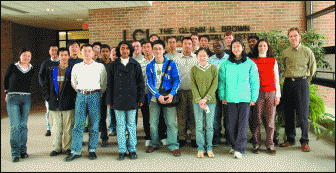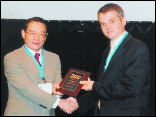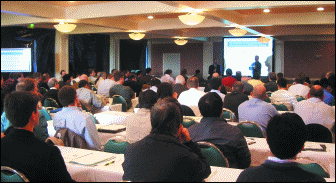The Establishment of the First SID Student Branch and a Student Scholarship Program
by Robert L. DonofrioDirector, Metropolitan Detriot Chapter
The Greater Dayton (Ohio) Chapter has established the first SID student branch at Kent State University in Kent, Ohio. The Student Branch, founded through the work of Chapter Chair Dr. Darrell Hopper and Dr. Phil Bos, a SID member and professor at Kent State University, is SID's first official Student Branch. With Dr. Bos serving as faculty advisor, the Kent State Student Branch of the SID has more than 25 members and maintains the same executive structure as a regular chapter, with a president, Cheng Chen; vice president, Ye Yin; secretary, Hari Atkuri; and treasurer, Ebru Buyuktanir.
Pictured are the founding members of SID's first official student branch, which is located at Kent State University in Kent, Ohio. Dr. Philip Bos (far right) serves as the faculty advisor. Branch President Cheng Chen is front and center (in the blue jacket).
Additionally, the Greater Dayton Chapter has donated $2000 for a scholarship program at the Liquid Crystal Institute at Kent State University. The award is still awaiting the first recipient. The faculty has decided to make the award during the spring 2006 semester because they traditionally use the spring semester for their regular scholarship competitions (e.g., for the Samsung scholarship). The faculty decided it would be appropriate to have the SID award considered in the context of other awards. The students will write a micro-proposal as a competition entry as is required for other awards. Kent State expects to announce those awards in the late May to early June 2006 time frame.

Pictured are the founding members of SID's first official student branch, which is located at Kent State University in Kent, Ohio. Dr. Philip Bos (far right) serves as the facility advisor. Branch President Cheng Chen is front and center (in the blue jacket).
Dan Desjardins, Secretary/Program Chair, SID Greater Dayton Chapter, helped write this report.
The U.K. & Ireland Chapter Awards the 2005 Ben Sturgeon Award
Graham Woodgate has been awarded the 2005 Ben Sturgeon Award, which is offered annually by the U.K. & Ireland Chapter of the SID for outstanding work by a young scientist in a field related to liquid-crystal-display (LCD) technology. The award is named for Ben (Bennett) Sturgeon, who for many years was the research director of BDH, Ltd., both before and after the company became part of the E. Merck Group.
Among his many achievements, Sturgeon was the driving force behind commercialization of the cyanobiphenyl liquid crystals, then newly discovered by Professor George Gray and his colleagues in collaboration with the displays group at Malvern. His energy, focus, and judgment were an inspiration to the younger scientists who worked with him and are commemorated by the award.
This year's winner, Graham Woodgate, studied physics at Bristol University, achieving a first-class honors degree in 1987. He went on to Reading University where he earned a Masters of Science degree in applied and modern optics and was awarded the Pilkington Prize as top student in 1988.
Woodgate began his career as an optical engineer at Crosfield Electronics, Ltd., working on the development of a novel high-productivity 6000-dpi scanner for the printing industry. In 2001, he founded Ocuity, Ltd., in Oxford with Jonathan Harrold. Originally, the company provided high-value technical consultancy services in optical and electronic projects for the electronic-display and fiber-optic-telecommunications industries. Their research led to the invention and demonstration of a new class of optical architectures suitable for flat-panel displays (FPDs) called Polarization Activated Microlens™. This technology may be used for brightness enhancement, which is particularly important for organic light-emitting-diode (OLED) and transflective displays as well as to produce very-high-quality high-efficiency low-cost switchable 2-D/3-D displays. This technology has been protected by a portfolio of 12 patents, the fundamental one of which is now granted. The technology has recently been licensed to a major manufacturer in Asia for production. The work has also been published at the IDW '03 and in IDW '04, where it was the recipient of the SID Outstanding Paper Award.
At the Opening Ceremony of EuroDisplay 2005, held in September 2005 at the Edinburgh International Conference Centre, in Edinburgh, Scotland, then SID President Shigeo Mikoshiba presented the Ben Sturgeon Award for 2005 to Graham Woodgate.
 John Mansel
John Mansel
Then SID President Shigeo Mikoshiba presenting the 2005 Ben Sturgeon Award to Graham Woodgate.
Alan Mosely and John Mansell submitted information for this article.
JSID Listed in Thomson's Science Citation Index Expanded
by Jessica Quandt
The
Journal of the Society for Information Display (JSID) can now be found listed on Thomson Scientific's Science Citation Index Expanded (SCIE), a major subscribers-only index and database used heavily by universities and other academic institutions.
JSID is now listed as a part of Thomson's ISI Web of Science
®, which calculates an up-to-date Impact Factor for each publication listed in SCIE based on the number of citations. This is an accepted metric for gauging the importance of a publication and also of the individual papers published in it.
This is an important turning point for JSID, according to the Journal's Editor, Dr. Andras Lakatos, because many academic institutions around the world acknowledge or credit scientific publication records based exclusively on papers that appear in SCIE-listed publications. Therefore, JSID's listing in the SCIE should expand the Journal's reach to academic researchers who may have refrained from submitting manuscripts in the past when JSID was not listed, Lakatos said.
JSID is the only monthly scientific journal that is devoted exclusively to the science and technology of displays and display-related developments in materials, electronics, and imaging. It is published monthly in full color and is available online at http://www.aip.org/ jsid.
For more information on Thomson's SCIE, visit http://www.isinet.com/.
L.A. Chapter: One-Day LED Symposium Review
by Edwin Bernard
If someone had told me 15 years ago that light-emitting diodes (LEDs) would be a hot topic in the field of displays today, I would have tried to sell them a bridge in Brooklyn! LED displays for the mainstream were of low brightness in the dot-matrix and segmented variety. My, how far we have come since then. In January, the Los Angeles Chapter of SID put on a One-Day Symposium on LEDs, and the attendance was beyond our expectations as 150 attendees filled the room to capacity to hear talks on how LEDs are being used to illuminate liquid-crystal displays (LCDs), digital micromirror devices (DMDs), and other microdisplay products.
This was the third One-Day Display Sym-posium, which also included a small exhibition, held by the LA Chapter since 1990 and the first on LEDs. Larry Tannas, Chair of the Los Angeles SID Chapter and President of Tannas Electronics, chaired the LED Symposium. Program Chair William Kennedy, General Manager of Toyoda Gosei America, pulled together a stellar array of speakers who provided a wealth of information on this hot topic.
Dr. Eric Bretschneider kicked off the sym-posium with a primer on the "Fundamentals of High-Brightness LEDs." He navigated through the history and materials science of the technologies used today, such as phosphides (red), nitrides (blue and green), white photo-conversion, and other aspects such as efficiencies, photometric phenomena, color matching, etc.
LED performance can be enhanced with non-imaging optics that uses less depth than imaging optics. Dr. David Pelka showed us how to use primary total internal reflection (TIR) to secondary optics for effective light capture, collimation, and shaping. These processes are applicable from the micro to the macro levels. The TIR approach is also effective for illumination applications such as lighting lenses in flashlights.
Our very own Dr. Munisamy Anandan gave a dynamic talk on using LEDs as the illumination source for direct-view and projection LCDs, as well as color-field-sequential applications. When a display medium can be cycled sufficiently fast, the red, green, and blue LEDs can be synchronized to provide the red, green, and blue component in sequence. This has the advantage of maximizing aperture ratio and, subsequently, display quality.
Most of us use cell phones, portable digital assistants, and music players, and LED lighting is playing a key role in backlighting LCDs used in these products. Steve Yeung who has a wealth of experience in commercial and electronic product design, gave us examples of how LEDs are used to make these products thinner and smaller compared to the use of other light sources such as fluorescent lamps.
Projection displays need very-high-intensity light sources to be viable. Who would have thought that LEDs would be approaching the effectiveness of arc lamps traditionally used in these products? Dr. Miller Schuck of Brillian Corp. provided details on how LEDs are used in emerging products such as the portable electronic projector based on LCoS devices.
Robert Smith-Gillespie, President and Principal of FPD Design Consulting LLC, talked about "Large-Format Color LCDs with LED Lighting for Fixed-Use Applications. Today, LEDs are not only used in small-format displays, but are being used in 7-in.-and-larger formats, especially in fast-response applications.
Head-mounted displays have not made it into the consumer market yet. However, with the use of low-voltage less-bulky LEDs as the light source, this situation may change. Stephen Marsland, Senior Partner in the McLaughlin Consulting Group, gave a presentation on rugged, portable, head-up viewers for industry, medicine, aerospace, law-enforcement, and home applications. He also discussed the latest in LED-illuminated microdisplay-based large-screen rear-projection TV technologies.
Chris Connery of DisplaySearch talked about how LEDs are becoming more important for lighting, everything from desktop monitors and video-camera viewfinders to rear-projection TVs. He charted a road map on what this all means and where is it going. Clearly, the consumer will be benefiting from some exciting products in the future that use LEDs to illuminate displays.
Samsung kindly supplied two 19-in.-plus color active-matrix LCDs – one backlit with a conventional array of fluorescent lamps and the other with LEDs. It was easy to pick out the LED-backlit display by virtue of the larger color gamut, especially in red.
More details on the above presenters can be obtained from the SID LA Web-site archive at http://www.sidchapters.org/la/january_2006.html
LEDs are continuing to increase in efficiency and light output. Thermal management techniques are also becoming more sophisticated to facilitate the driving of LEDs at higher power levels. LEDs are used, for example, in traffic signals and for automobile lighting, outside and inside, and will be moving into the realm of general illumination where life-cycle costs can be significantly reduced. In light of the bright future of LEDs, the LA Chapter is seriously considering maintaining the same topic for the January 2007 One-Day Symposium and expand-ing it to address giant-screen LED displays.

Packed meeting hall for the LA Chapter's One-Day Symposium on LEDs.
Edward Bernard can be reached at 818/554-0007, e-mail: EdBinLA@aol.com.
Please submit noteworthy chapter activities to the SID Chapter News editor, Robert L. Donofrio, at donofrio@displayconsultants.com.